Over the past three decades, the Chinese economy has experienced unprecedentedly rapid growth. Social progress, technological innovations, and increasing disposable personal incomes have shaped new shopping habits. A variety of e-commerce modes, like live-streaming e-commerce, social e-commerce, and cross-border e-commerce, have emerged in the market. Large Chinese e-commerce platforms, like Alibaba’s Taobao and JD.com, have dominated the industry for many years, but strong competitors, like Douyin and Pinduoduo, have jumped in as well.
According to an e-commerce report from China’s Ministry of Commerce, in 2019, national e-commerce transactions reached 34.82 trillion yuan, including online retail sales of 10.63 trillion yuan, an increase of 16.5% over last year, and online retail sales of physical goods amounted to 8.52 trillion yuan, accounting for 20.7% of the total retail sales in the market.
Due to the global pandemic, e-commerce in China is predicted to grow further and account for more than 50% of retail sales in the following years. China has the highest rate of e-commerce in any country as a percent of total retail sales.
The statistics make it clear that any brand hoping to reach Chinese consumers must be on some form of e-commerce.
Guide to Chinese e-commerce platforms
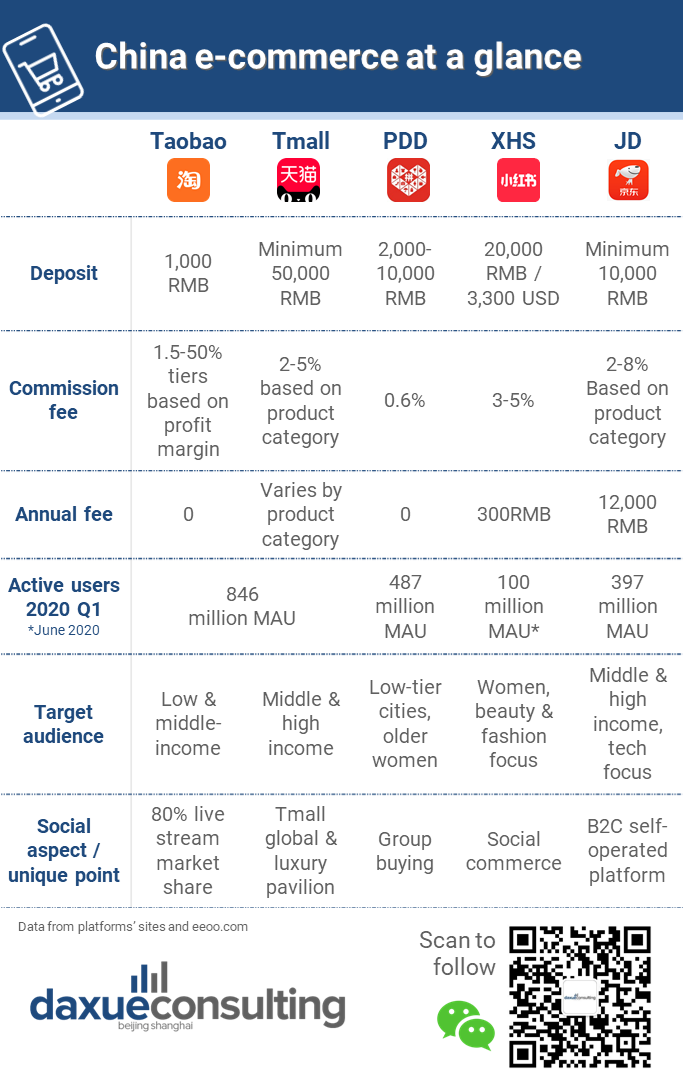
Taobao
Taobao is the biggest consumer-to-consumer (C2C) e-commerce platform in China, while Tmall is the biggest business-to-consumer (B2C) e-commerce platform. The internet and technology company Alibaba Group, headquartered in Hangzhou China, owns those two largest e-commerce websites.
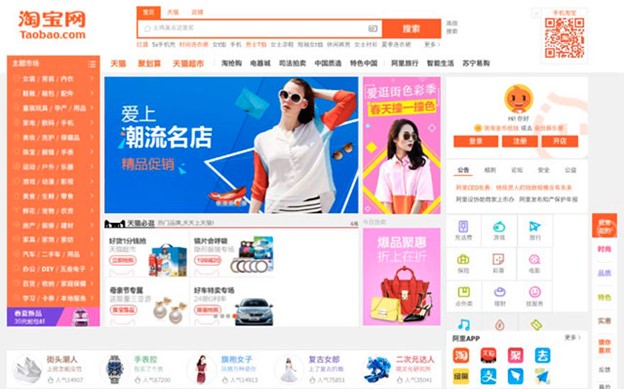
Source: Taobao official website; Screenshot of Taobao homepage
Most of the merchants on Taobao are individuals and small businesses. They offer a wider array of products, from clothing to electronics, from books to virtual products (like gift cards). Because of the low cost and low operating risk, selling on Taobao is one of the best channels for many manufacturers and brands.
Most of the buyers on Taobao make a purchase online using their mobile devices. According to Alibaba Q4 2020 report, monthly active mobile users reached 902 million and annual active consumers reached 779 million with an increase of 22 million in a single quarter. Alipay, the mobile payment method from Alibaba, enables Chinese consumers to make a payment within 10 seconds on Taobao and other e-commerce platforms in China.
In 2020, live-streaming brought a new breakout point to Chinese e-commerce platforms. Alibaba’s Taobao Live has around 80% share of this live-streaming cake. In the past 12 months, gross merchandise volume (GMV) from Taobao Live exceeded RMB 400 billion, with a growth rate of more than 100%. Not only Gen-Z and Millennials but also middle-aged and senior Chinese consumers are getting on the trend. Live-streaming is a way to help brands gain awareness, get in touch with customers directly and move inventory pressure.
Tmall
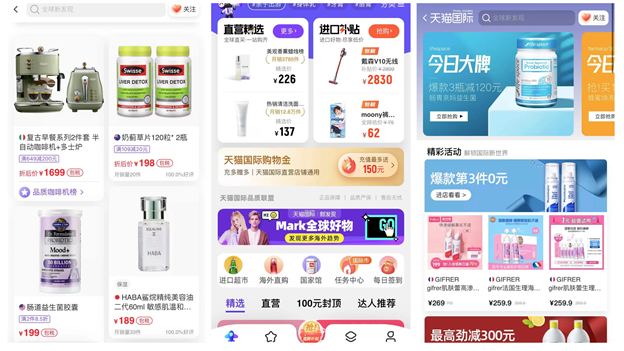
Source: Tmall. Screenshots of Tmall Global
Tmall, or Taobao Mall, is based on the Taobao platform but operates separately. Most of its merchants are official stores. Offical stores refer to the seller must be a legal entity in China’s company registration system. All goods on Tmall are official and authentic, and therefore the average price is relatively higher than Taobao. Due to the guaranteed authenticity, many consumers prefer to shop on Tmall rather than Taobao, particularly for middle-class and young Chinese consumers who have a higher education background. In addition, Tmall is going global in recent years.
During the COVID-19 pandemic period, Tmall Global, the Tmall’s cross-border B2C marketplace, saw a rapid growth in international goods into China. As of December 31, 2020, the number of international brands and merchants on Tmall Global increased 60%, and the Paid GMV on Tmall Global also grew 37% year-over-year. Clothing, household items and foods lead the way on Tmall Global, but luxury products are also catching up. For most Chinese consumers living far away from tier 1 cities, where international brands have physical stores, Tmall Global is a trustable and straightforward way.
Not only for international big names, but Tmall Global also helps small and medium-sized foreign brands sell to young Chinese consumers. US fashion brand Everlane opened a store on Tmall Global in 2019. Due to the pandemic, Everlane temporarily closed all retail stores in the U.S. since March 2020, but at the same time, increased investment in Tmall Global. From March to June, Everlane achieved great growth in the Chinese market.
JD.com

Source: JD.com official website; Screenshot of JD homepage
If comparing Taobao with eBay, JD.com is like Amazon. JD.com is the second-largest B2C platform in China. When Tmall was not yet established in 2008, JD.com was used to be the biggest direct sales marketplace in the B2C market. Even now, Tmall has gradually improved its product selling standards, but it sometimes gets in trouble with counterfeit goods. However, in terms of buying real and official products, JD.com still has the highest reputation among Chinese consumers.
JD.com mainly sells 3C products (computer, consumer electronics, and communication), such as smartphones, laptops, and home appliances. Products on JD.com are directly from brands and suppliers, and then directly ship to customers by JD.com official courier. With reliable and timely delivery, JD.com has a strong competitive advantage in Chinese e-commerce platforms.
In recent years, JD.com has collaborated with Walmart and other large supermarket chains for online shopping services. What’s more, supermarkets on JD.com also provide a one-hour delivery service for customers to shop for grocery goods. In 2020, JD Daojia, JD.com’s grocery services, the total GMV was RMB 21.3 billion, up 102.9% year-over-year. Active consumers on the platform were 37.3 million, with an increase of 77.1%.
Pinduoduo
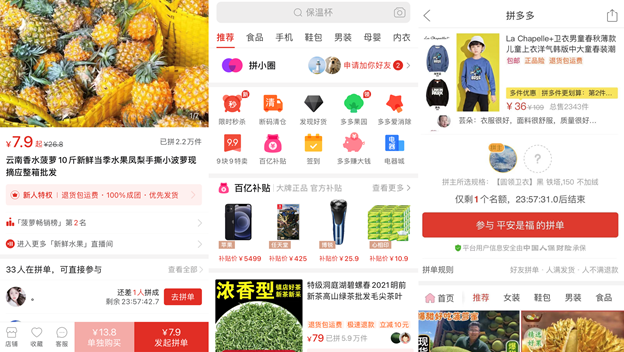
Source: Pinduoduo; Screenshot of the products detail page, homepage, and inviting page.
Pinduoduo is a new but competitive player in Chinese e-commerce platforms. Pinduoduo was founded in 2015, but it only took 4 years to reach a trillion-yuan GMV, while Alibaba took 14 years and JD.com took 19 years.
Social e-commerce is the key advantage of Pinduoduo. Consumers invite their friends over social media to buy goods and get discounts. The more people get involved, the higher the discount. This encourages buyers to share links with other people. Social media tools and gamification of shopping experiences make consumers addicted to Pinduoduo.
Pinduoduo targets consumers who are living in low-tier cities and have relatively low incomes. They enjoy much more time for leisure and social life than shoppers living in the 1-tier cities in China. The products on Pinduoduo are mainly household necessities and commodities, such as tissues, kitchen sets, and fruits.
Pinduoduo’s lasted financial report shows that by the end of 2020, the number of active buyers on Pinduoduo reached 788.4 million, growing 35% from 585.2 million at the end of 2019. Surprisingly, this number surpassed Taobao’s for the first time (which is 780 million in 2020). However, the average amount of spending per year was approximately 9,076 yuan on Alibaba’s e-commerce platforms, but on Pinduoduo it was only 2115.2 yuan.
Douyin
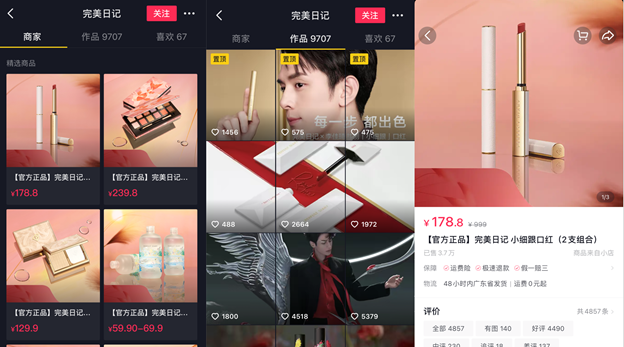
Source: Perfect Dairy, Douyin; Screenshot of the Douyin store page, homepage, and the products detail page.
One of the most popular social media platforms, the Chinese version of TikTok, Douyin, is also developing its e-commerce platform. ByteDance, the owner of Douyin, has established an e-commerce department as the first level business unit since June 2020.
The unique power of ByteDance, the content-based recommendation system, is seen as the strongest advantage of Douyin to join the e-commerce battlefield in China. Additionally, millions of internal traffic from the Douyin short video platform help Douyin e-commerce attract buyers for free. As of February 2020, the GMV of Douyin E-commerce has exceeded 500 billion yuan, more than triple that of 2019.
Xiaohongshu (RED)
Xiaohongshu is a lifestyle sharing platform that allows users to post their notes on products, travel, and almost everything. Using this social-commerce app has become a very important step for many Chinese consumers before purchasing. It launched its cross-border e-commerce business in 2014. Most of the brands are cosmetics, and over 80% of Xiaohongshu users are female.
VIP.com
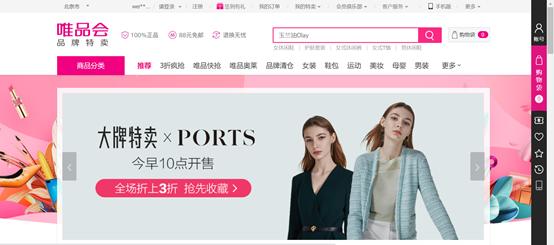
Source: VIP.com official website; Screenshot of VIP homepage
VIP.com is the largest flash sales e commerce platform in China, targeting high-income consumers. It is often used for buying fashion apparel, shoes, and bags, cosmetics, home goods, etc. VIP.com works with more than 30,000 brands in total, and more than 2,200 of the brands are exclusive online partners with VIP.com. Its business model is known as “brand discount + Time-limited deals + Certificated products.” Every day, hundreds of brands offer customers “incredible” discounts, usually up to 70% discount, to attract time-limited deals. It functions as an online outlet store by selling excess inventory at discount prices.
Products include apparel, children’s clothing, beauty, mother and baby care, accessories, leather goods, perfumes, etc. Most of them are well-known brands such as Nike, Dior etc. New items will be released at 10 am and 8 pm every day, 100% authenticity guarantee, limited purchase, support cash on delivery, unconditional return within seven days. The user interface design is like Douyin, as they scroll down customers can see a continuous flow of new brands, creating a never-ending shopping experience.
Weidian, WeChat’s e-commerce platform

Source: Weidian; Screenshot of the products detail page, homepage, and inviting page
Weidian is based on the WeChat platform, and is an e commerce platform purely based on mobile phone applications. Anyone can own a store on Weidian. In fact, Weidian has developed two apps, one for buyers and one for brand managers (owners). Weidian brand managers is an app to help entrepreneurs grow their interests and create brands. Nowadays, the Weidian platform has nearly 90 million store owners. It has become the preferred platform for consumers in many fields such as dolls, Hanfu, slimes, specialty coffee, pastries, and local specialties.
What brands need to know about Chinese ecommerce platforms
- Taobao and Tmall are comprehensive e commerce platforms and suitable for almost all brands.
- Live-streaming can be found everywhere in the Chinese e commerce industry. Brands would better find good KOLs for their e-commerce stores.
- On most e-commerce platforms in China, buyers are able to talk directly with sellers over the real-time chat tool within the platform, because Chinese consumers like efficient methods. Therefore, before and after the sale, customer service is important for brands.
- Since most buyers are from mobile devices, brands should design the store page mobile-friendly on e-commerce platforms in China, although most platforms offer pc websites version.





